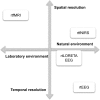Real-time functional magnetic resonance imaging in obsessive-compulsive disorder
- PMID: 28744133
- PMCID: PMC5513821
- DOI: 10.2147/NDT.S121139
Real-time functional magnetic resonance imaging in obsessive-compulsive disorder
Abstract
The current literature provides substantial evidence of brain alterations associated with obsessive-compulsive disorder (OCD) symptoms (eg, checking, cleaning/decontamination, counting compulsions; harm or sexual, symmetry/exactness obsessions), and emotional problems (eg, defensive/appetitive emotional imbalance, disgust, guilt, shame, and fear learning/extinction) and cognitive impairments associated with this disorder (eg, inhibitory control, working memory, cognitive flexibility). Building on this evidence, new clinical trials can now target specific brain regions/networks. Real-time functional magnetic resonance imaging (rtfMRI) was introduced as a new therapeutic tool for the self-regulation of brain-mind. In this review, we describe initial trials testing the use of rtfMRI to target brain regions associated with specific OCD symptoms (eg, contamination), and other mind-brain processes (eg, cognitive - working memory, inhibitory control, emotional - defensive, appetitive systems, fear reduction through counter-conditioning) found impaired in OCD patients. While this is a novel topic of research, initial evidence shows the promise of using rtfMRI in training the self-regulation of brain regions and mental processes associated with OCD. Additionally, studies with healthy populations have shown that individuals can regulate brain regions associated with cognitive and emotional processes found impaired in OCD. After the initial "proof-of-concept" stage, there is a need to follow up with controlled clinical trials that could test rtfMRI innovative treatments targeting brain regions and networks associated with different OCD symptoms and cognitive-emotional impairments.
Keywords: neurofeedback; neuromodulation; obsessive-compulsive disorder; real-time fMRI; self-regulation.
Conflict of interest statement
Disclosure The authors report no conflicts of interest in this work.
Figures




References
-
- American Psychiatric Association . Diagnostic and Statistical Manual of Mental Disorders. 5th ed. Arlington, VA: American Psychiatric Publishing; 2013.
-
- Stein DJ, Kogan CS, Atmaca M, et al. The classification of obsessive-compulsive and related disorders in the ICD-11. J Affect Disord. 2016;190:663–674. - PubMed
-
- Abramowitz JS, Jacoby RJ. Obsessive-compulsive disorder in the DSM-5. Clin Psychol Sci Pract. 2014;21(3):221–235.
Publication types
LinkOut - more resources
Full Text Sources
Other Literature Sources

